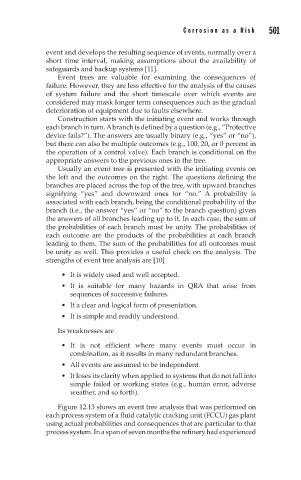Page 535 - Corrosion Engineering Principles and Practice
P. 535
500 C h a p t e r 1 2 C o r r o s i o n a s a R i s k 501
event and develops the resulting sequence of events, normally over a
short time interval, making assumptions about the availability of
safeguards and backup systems [11].
Event trees are valuable for examining the consequences of
failure. However, they are less effective for the analysis of the causes
of system failure and the short timescale over which events are
considered may mask longer term consequences such as the gradual
deterioration of equipment due to faults elsewhere.
Construction starts with the initiating event and works through
each branch in turn. A branch is defined by a question (e.g., “Protective
device fails?”). The answers are usually binary (e.g., “yes” or “no”),
but there can also be multiple outcomes (e.g., 100, 20, or 0 percent in
the operation of a control valve). Each branch is conditional on the
appropriate answers to the previous ones in the tree.
Usually an event tree is presented with the initiating events on
the left and the outcomes on the right. The questions defining the
branches are placed across the top of the tree, with upward branches
signifying “yes” and downward ones for “no.” A probability is
associated with each branch, being the conditional probability of the
branch (i.e., the answer “yes” or “no” to the branch question) given
the answers of all branches leading up to it. In each case, the sum of
the probabilities of each branch must be unity. The probabilities of
each outcome are the products of the probabilities at each branch
leading to them. The sum of the probabilities for all outcomes must
be unity as well. This provides a useful check on the analysis. The
strengths of event tree analysis are [10]
• It is widely used and well accepted.
• It is suitable for many hazards in QRA that arise from
sequences of successive failures.
• It a clear and logical form of presentation.
• It is simple and readily understood.
Its weaknesses are
• It is not efficient where many events must occur in
combination, as it results in many redundant branches.
• All events are assumed to be independent.
• It loses its clarity when applied to systems that do not fall into
simple failed or working states (e.g., human error, adverse
weather, and so forth).
Figure 12.13 shows an event tree analysis that was performed on
each process system of a fluid catalytic cracking unit (FCCU) gas plant
using actual probabilities and consequences that are particular to that
process system. In a span of seven months the refinery had experienced

